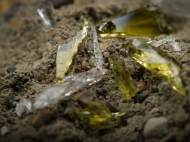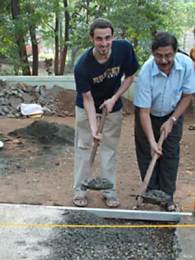More environmentally friendly and less costly cement developed
 Two separate research groups have applied two different approaches to improve cement in order to make it more durable and greener. Researchers from the Michigan State University have found that mixing ground waste glass into the cement makes resulting concrete stronger, more durable and more resistant to water, while Drexel University researchers found a way to lower its cost and make it more environmentally friendly.
Two separate research groups have applied two different approaches to improve cement in order to make it more durable and greener. Researchers from the Michigan State University have found that mixing ground waste glass into the cement makes resulting concrete stronger, more durable and more resistant to water, while Drexel University researchers found a way to lower its cost and make it more environmentally friendly.
“Milled glass enters a beneficial reaction with cement hydrates, so basically the chemistry of the cement improves with the glass”, said Parviz Soroushian, MSU professor of civil and environmental engineering who has been studying the glass-concrete mix. “It makes it stronger and more durable and doesn’t absorb water as fast as regular cement.”
About 20 percent of the cement that is used to produce the concrete is replaced by milled, or finely ground, glass. The resulting concrete is a little lighter in color, but the difference is mostly indistinguishable. Contrary to cement, the lower temperatures needed to process milled glass significantly reduce the amount of energy used, as well as CO2 emissions. The process is also beneficial because it reduces the amount of glass that ends up in landfills.
“We anticipate that this novel practice of partially replacing cement in concrete with mixed-color waste glass, which is based on sound chemical principles and the pioneering laboratory work conducted at MSU, will yield significant environmental, energy and cost benefits”, said Roz Ud-Din Nassar, a doctoral student in civil and environmental engineering who was also involved in this project.
For more information, read the article published in the journal Construction and Building Materials: “Strength and durability of recycled aggregate concrete containing milled glass as partial replacement for cement”.
Researchers from Drexel University used a different approach by improving ordinary Portland cement (OPC) to make it more energy efficient and cost effective to produce. Drexel’s “green” variety is a form of alkali-activated cement that utilizes an industrial byproduct, called slag, and a common mineral, limestone, and does not require heating to produce. Although alkali-activated cement has been used as far back as the 1950s and 1960s in several buildings in the former Soviet Union, much of the inspiration for this research came from the Pyramids in Egypt, as well as buildings in ancient Rome.
“Our cement is more like ancient Roman cement than like modern Portland”, said Dr. Alex Moseson, one of the lead researchers on the project. “Although we won’t know for 2,000 years if ours has the longevity of Roman buildings, it gives us an idea of the staying power of this material.”
In contrast to ordinary Portland cement which requires clinker, Drexel’s cement is made of up to 68 percent unfired limestone, a small amount of commercial alkali chemical as well as iron slag byproduct. According to Dr. Michel W. Barsoum, A.W. Grosvenor professor in the Drexel University Department of Materials Science and Engineering, this alternative production method lessens the cost of materials needed to create cement by about 40 percent, and it reduces energy consumption and carbon dioxide production by 97 percent.
“Our results and the literature confirm that it performs as well or better than OPC”, said Barsoum. “We are very close to having the cement pass an important commercialization milestone, ASTM C1157, a standard that judges cement-like products on performance, such as strength and setting-time, regardless of composition.”
For more information, read the paper published in Cement and Concrete Composites: “High volume limestone alkali-activated cement developed by design of experiment”.










Leave your response!